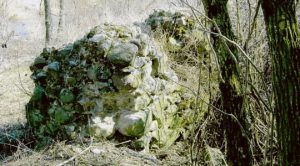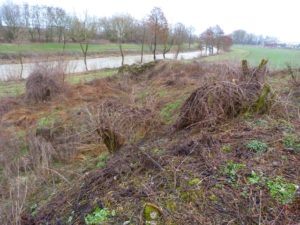Szabatkapuszta

The ruined castle of Szabatka or Szabatkapuszta is located in the Upper lands/Horná zem/Felvidék, in Slovakia. The castle’s name shouldn’t be confused with the great town of Szabadka which can be found on the southern part of the Great Hungarian Plain, in Serbia.
Szabatkapuszta is in Gömör County, right next to the once-rich market town of Rimaszombat (Rimavská Sobota) at the River Rima. It used to be an important (mainly palisade) fort, built by the Bohemian soldiers at the time when Jan Giskra’s Hussites were called into Hungary by Queen Erzsébet in the 1440s.

When King Matthias Corvinus took back the central part of Upper Hungary in 1459, the castle was also taken from them in 1460. Then, the king had the palisade destroyed. Again, it gained importance during the Ottoman wars when the area became a war zone. The Turks got it in 1553 and Bey Mehmed of Fülek castle had the fort rebuilt by forcing the peasants of the area to build it up in 1555. The earth-wooden palisade was built in „Hungarian fashion”, they built two rows of the palisade and they filled the gap between them with clay and earth.
According to the Ottoman pay lists, they had 32 Janissaries in it, besides the other defenders in 1558. Szabatkapuszta became part of the Sandjak of Fülek (Filakovo) castle. The Turks had used this fort for four decades as one of their most northern bases to raid the area around the cities of Kassa (Kosice, Kaschau), Eger, and Szikszó.

King Habsburg Ferdinand instructed General Lázár Schwendi in 1566 to drive out the infamous robber knight called Bebek György from Upper Hungary. The mercenaries took his castles one by one, including the castles of Krasznahorka, Pelsőc (Plešivec), and Gombaszög (Gombasek). They took the castle of Szádvár as well, despite its heroic defense by the widow of Bebek György, Lady Palóchy Zsófia. (Please, note that I use the Oriental name order for Hungarians where family names come first.)

This was the time when the small fort of Szabatka was taken back from the Turks for a short period by the troops of Lázár Schwendi and Simon Forgách Simon. They supplied it with a garrison of the king in 1566. The next year, the Turks of Fülek castle, led by Bey Hassan of Temesvár, attacked Szabatka castle and took it. The Bey used to be its captain before and they were so happy and triumphant for regaining the fort that they made another raid immediately against the area of Putnok where they pillaged the land and destroyed Putnok castle, too. Read more about Putnok Castle here:
https://www.hungarianottomanwars.com/kingdom-of-hungary/putnok/
The Ottomans took the castles of Ajnácskő and Várgede in 1571 and they had Szabatka reinforced, too. At the end of the first year of the 15-Year War against the Turks, Báthory István, Chief Judge of the Country, and Christoph Teuffenbach, Chief Captain of Upper Hungary, gathered the nobles of Upper Hungary. They led a campaign against the castles of Nógrád and Hont County. Their campaign began on 14 November 1593 and was finished on 7 December, with significant success.

Their first siege was laid against the castle of Szabatka between 15 – 18 November. The men of Rákóczi Zsigmond, Drugeth István, Dobó Ferenc, and Báthory István joined Teuffenbach and their army numbered altogether 12-16,000 men. Yet, the defenders were only between 250-400 soldiers. The Turks were heroically defending the small castle and the fight was particularly fierce. Finally, the cannons ruined the outer palisade and the Turks got stuck in the inner castle. The final assault was launched on November 18, in the early afternoon. The Turks fought until the last man. The castle was utterly destroyed and has never been rebuilt.

The Hungarian army went on to take Fülek castle which fell to them on November 27, after a week-long siege. The ruins of the castle of Szabatkapuszta / Törökvár are now hidden under a thicket, some stone cellars still can be seen. The rest of the remains are in an agricultural area. It would be worth taking care of the site. Not only the big, pompous castles deserve the respect and the admiration of posterity.

The history of Hungary (and of Christian Europe) was decided in smaller castles like Szabatkapuszta, all along the 1,000 miles of its Borderland where unknown soldiers fell in unrecorded fights during the Ottoman wars between 1368 and 1699. To me, the place at Rimaszombat is special because part of my family had come from Gömör County, from Felsővály (Vyné Valice) was not far from the small fort of Szabatka. You can read more about Felsővály here, the village is famous for its fortified church:
https://www.hungarianottomanwars.com/kingdom-of-hungary/felsovaly/
Sources: Szibler Gábor, Rastilaw Tóth, Hajdú István, Index

Dear Readers, I can only make this content available through small donations or by selling my books or T-shirts:
Please, feel free to support me with a coffee here:
You can check out my books on Amazon or Draft2Digital, they are available in hardcover, paperback, or ebook:
https://www.amazon.com/dp/198020490X or at https://books2read.com/b/boYd81

My work can also be followed and supported on Patreon: Become a Patron!http://Become a Patron!
[wpedon id=”9140″]

https://hungarianottomanwars.myspreadshop.com/all


